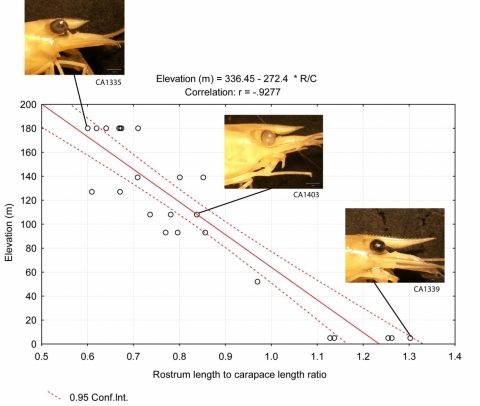
de Mazancourt, V., Marquet, G. & Keith, P. (2017). The «Pinocchio-shrimp effect»: first evidence of variation in rostrum length with the environment in Caridina H. Milne Edwards, 1837 (Decapoda: Caridea: Atyidae). Journal of Crustacean Biology rux025, 1-9. DOI: 10.1093/jcbiol/rux025
External morphology has always been the first criterion used to separate species of shrimps, especially in the freshwater genus Caridina H. Milne-Edwards, 1837, but more doubts have been expressed regarding the relevance of some of the morphological characters. We collected 27 specimens of Caridina from seven different localities during field work conducted on the island of Pohnpei (Federated States of Micronesia). After genetic verification that they all belonged to the same species, 19 morphological variables were measured and correlated with the elevation of the collecting stations using correlation analyses. We provide evidence that the length of the rostrum showed strong negative correlation with the elevation. This could be explained either by the physical stress exerted on the rostrum by the stronger water currents in the stations at a higher elevation, as a defence against predators in the lower stations, or a combination of both possibilities. The taxonomy of these shrimps is thus challenging and should not rely only on rostrum length, but on other characters such as the number of teeth on the dorsal margin of the carapace, which is not correlated with rostrum length and therefore, with the environment.
Contact:
Valentin de Mazancourt, PhD student in 1 and 4 teams, valentin.demazancourt@laposte.net
Philiipe Keith, professor MNHN, in team 4, philippe.keith@mnhn.fr
